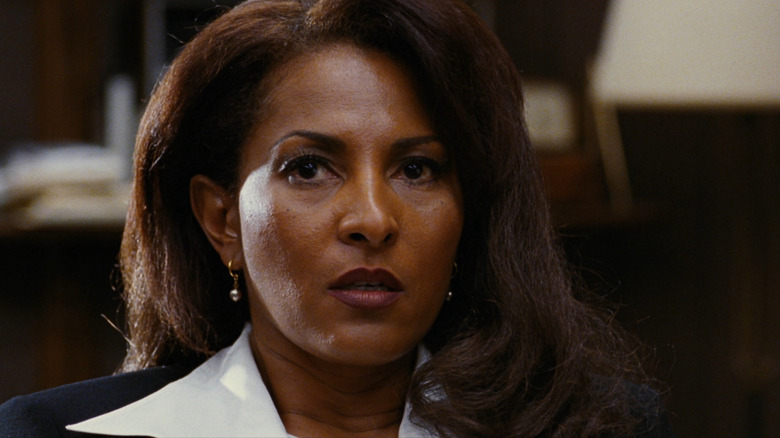Quentin Tarantino's 'Single Biggest Addition To Jackie Brown' Confused Elmore Leonard
"Jackie Brown" has always been an outlier in the filmography of Quentin Tarantino. Some people feel it is his best, most mature film. Some feel like it's missing some of that signature Tarantino personality. This somewhat divisive nature comes from the fact that this is the only time in his career he adapted someone else's material for a movie. "Jackie Brown" is based on the Elmore Leonard novel "Rum Punch." By and large, the film is pretty faithful to Leonard's novel. Sure, there are changes, like transplanting the action from Miami to Los Angeles and notably making the lead character a Black woman instead of a white one, but in terms of the story beats, it's pretty similar.
When translating a piece of material into an entirely new medium, changes have to be made, despite what countless book readers online will tell you. How you ingest information, character, emotion, and plot in a visual medium is entirely different than through words alone. Also, the story is being told through an entirely new prism. Quentin Tarantino may love Elmore Leonard, but that doesn't mean he is Elmore Leonard. Naturally, he is going to bring in his own ideas in his adaptation. It would be disappointing if he didn't. When a filmmaker does this, the original author is either glad the new one is making it their own or are furious that their work is being changed (i.e. Stephen King hating Stanley Kubrick's "The Shining").
In the case of "Jackie Brown," there wasn't much to get under Leonard's skin. However, there was one section invented for the film that left him a bit befuddled, but without it, we would have been deprived of our small dose of Chris Tucker.
'The Beaumont situation'
Before the story of Pam Grier's titular character really begins, we are following Samuel L. Jackson's gun runner Ordell bailing out one of his underlings from jail named Beaumont (Tucker). Believing that someone as weak-willed as Beaumont gave up information to the police, Ordell kills Beaumont in the trunk of a car. This all was not in "Rum Punch." Speaking with Creative Screenwriting back in 1998, Quentin Tarantino explained why he created this side story and felt it was crucial to the full tapestry of "Jackie Brown:"
"The single biggest addition I made to the book is the whole Beaumont section. Of all the structural things in the movie, I think that is the best thing I brought to it ... You get to understand Ordell's situation and what's going on with Jackie through the Beaumont situation, cause you've just been through that. It's like a movie unto itself for the first twenty minutes."
I couldn't agree more with Tarantino here. "Jackie Brown" is a movie obsessed with process and logistics. The entire third act is seeing a crafted plan come to fruition from several different points of view. This particular process lets us experience the ruthlessness of Jackson's Ordell, which subsequently enhances the tension whenever he shows up on screen afterward. Elmore Leonard, though, didn't get it on a first read of the script. Tarantino continues:
"He didn't think it was important? But by spending twenty minutes with Beaumont here, that's a really neat shorthand I can do for the rest of the flick. 'Cause you know Ordell's modus operandi."
Even though he didn't initially understand it, it doesn't sound like he was pushing back too hard on Tarantino and ultimately let him make the movie he wanted to make. I know I'm thankful for that.

